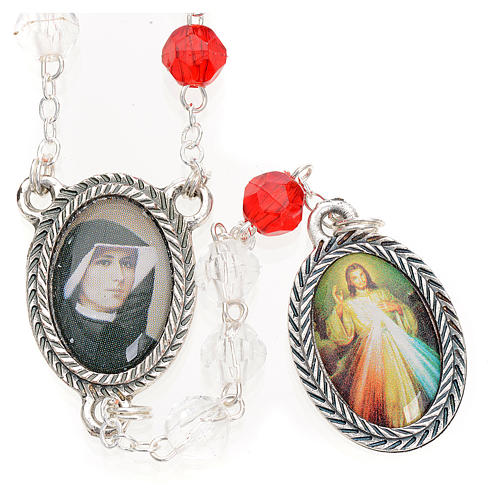Lenten Campaign 2025
This content is free of charge, as are all our articles.
Support us with a donation that is tax-deductible and enable us to continue to reach millions of readers.
32) Pray a Divine Mercy Chaplet as you are traveling to or from work. — 56 Ways to Be Merciful During the Jubilee Year of Mercy, Aleteia
I was away from the Church when the Divine Mercy devotion first became popular. I remember a publishing colleague referring to the newly canonized Saint Faustina Kowalska and asking “Saint Whosie What?” The first time I encountered the image of Jesus the Divine Mercy, I was less than impressed. I confess I thought it was the kind of art sold next to paintings of Elvis on velvet and dogs playing poker. None of this made me particularly open to what was for me an unfamiliar devotional practice, praying the Divine Mercy Chaplet.

Read more:
Divine Mercy rosary beads
But mercy, unlike economics, trickles down unfailingly, finding the cracks in hearts made hard and cynical, easing them open to healing. Through the mercy of friends, I went to Rome on pilgrimage in 2010. Our first morning Mass was celebrated in Santo Sprito in Sassia, the gorgeous church just outside the Vatican dedicated by Saint John Paul II to the Divine Mercy. There was That Image, on a banner towering over our pilgrim band. Still separated from the Church then, I abstained from communion. But that morning, I felt a sudden, deep and real longing to return. Mercy at work, softening and inviting.
I did return to the Church in Advent of 2010, inexorably driven by the fruit of that pilgrimage. But though I found new joy in practices I had once abandoned – the rosary, Adoration – I felt no call to explore the Divine Mercy. Then, another pilgrimage in 2012, this time to the Marian shrines of Portugal, Spain, and France, put me in company with pilgrims who had a regular habit of praying the Chaplet of Divine Mercy every day at 3 p.m., the time (traditionally associated with the moment of Jesus’ death on the cross) Saint Faustina called “the hour of mercy.” Our group began to pray the chaplet together every day at 3, pausing wherever we were or joining in prayer on our buses. In the Almudena Cathedral of Madrid, our tour director arranged to make a recording of our prayer, led by a young Filipina pilgrim who was discerning a call to religious life. At the end of the trip, we received copies of the recording on CDs, so we could bring the experience to life again from our homes.
The prayers of the chaplet, composed by Saint Faustina, are simple and unsentimental, focusing on offering the sufferings of Jesus in atonement for both personal and global sin, and imploring that God “have mercy on us, and on the whole world.” This repeated litany – Lord, have mercy, Kyrie eleison – is one of the oldest prayers of the Church, East and West, and one never out of season.
Especially now, especially now. This week’s suggestion for practicing mercy in the Jubilee Year — Pray a Divine Mercy Chaplet as you are traveling to or from work – is a simple way to put before God our own and our world’s deep need for the trickling down, the bubbling up of mercy.
If you have never prayed the Divine Mercy Chaplet, this may be the time to explore it. For those unfamiliar with chaplets (the word means “little crowns”), they are groups of prayers counted off on circles of beads. The Divine Mercy Chaplet uses the beads of a standard Dominican (5-decade) rosary. After an optional opening prayer and traditional prayers prayed on the cross and introductory beads, the chaplet consists of 5 “decades” of prayer and intercession. On the Our Father beads, we pray:
Eternal Father, I offer you the Body and Blood, Soul and Divinity of Your Dearly Beloved Son, Our Lord, Jesus Christ, in atonement for our sins and those of the whole world.
And on each of the ten beads of each decade, we pray:
For the sake of His sorrowful Passion, have mercy on us and on the whole world.
The chaplet closes with the great Eastern prayer, “Holy God, Holy Mighty One, Holy Immortal One, have mercy on us and on the whole world,” repeated three times, and optional closing prayers. (For more on how to pray the chaplet, click here.)
You can pray the Divine Mercy Chaplet, like the rosary, alone or as a group, silently or aloud, using beads or counting on your fingers. If you travel to and from work in a group, you can pray together. If you’re driving alone, you can pray along with a recording. The chaplet is easy to pray on public transportation (I can testify) – and what you see out the bus windows or on the faces of your fellow train passengers can move you to ask God’s mercy even more fervently.
Give it a try. As they say, it couldn’t hurt.
